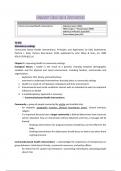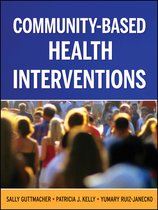Community Based Health Interventions
TO DO:
Mandatory readings
Community Based Health Interventions: Principles and Application by Sally Guttmacher,
Patricia J. Kelly, Yumary Ruiz-Janeck, 2010, published by John Wiley & Sons, inc. ISBN
978-0-7879-8311-6
Chapter 1: improving health in community settings
Ecological theory = health is the result of a dynamic interplay between demographic
variables and the physical and social environment, including families, communities and
organizations.
- keyfactors: SES, family, and work/school
- overview to understand interventions that take place in community setting
1. Health is a result of a fit between individuals and their environment
2. Environmental and social conditions interact with an individual to exert an important
influence on health
3. A multidisciplinary approach is necessary
→ Community-based health interventions
Community = group of people connected by visible and invisible links.
- for example: geographic location, physical boundaries (river), shared interests,
religion
- it’s important because how a target community is defined determines how resources
will be allocated, how an intervention will be delivered, and how a message will be
framed.
- Smoking interventions for pregnant women should focus on the effect for the
baby.
- Smoking interventions for adolescents should focus on how to act when there
is group pressure.
Community-based health interventions = acknowledge the importance of interpersonal or
group behavior, institutional climate, community resources, and policy effects.
- for where the HC system has limitations = preventing risk behavior, educating people
about risks
,Alma ata declaration
- definition for primary health = essential health care based on practical, scientifically
sound and acceptable methods and technology made universally accessible to
individuals and families in the community through their full participation and at a
cost that the community can afford to maintain at every stage of their development
in the spirit of self-reliance and self -determination ”
Primary prevention = vaccines, removing soda vending machines from school, wear your
seatbelt campaign
Secondary prevention = PAP tests, neonatal screening
Tertiary prevention = walking trails, removing soda vending machines from school, support
groups
Chapter 4: Levels and types of Community-Based interventions
Ecological perspective:
1. Group level = change knowledge, atti- tudes, and practices about a health issue
among members of a target group, such as women recovering from breast cancer or
new immigrants from Africa.
2. Organizational level = use the shared connection between individuals to build
changes in health behaviors and environment. Health promotion interventions at day
care centers or work sites take place at the organizational level. For example: a
school
3. Community level = interventions work to change environmental or social structures.
Any interven- tion that enhances the health of people throughout a geographic
community occurs at this ecological level. For example: all schools within a certain
area.
4. Policy level = change laws or policies that will facilitate health, such as no-smoking
bans in restaurants or mandatory seat belt laws.
→ at all levels there can be primary, secondary as well as tertiary prevention programs.
Interventions at the community level are bigger, take more time, and more resources →
collaboration is needed.
, Chapter 2: A brief history of community-based health interventions
Industrial revolution → improvement in health status (hygienic regulations) → more chronic
diseases → national health care: formalized, centralized, and paternalistic
Chronic diseases were a challenge to the medical system because of the multifaceted nature
and the ongoing treatment instead of curing a disease. → Public health to address lifestyle
factors
Early CbHI
North karelia project: respond to high mortality rate in CVD rural areas in Finland. Complete
community mobilization to alter norms and behaviors that contributed to early mortality of
middle- aged men from cardiovascular disease.
1. both health and non-health sectors and looked for opinion leaders both in the
medical community and out- side it to serve as public ambassadors for the program.
2. Use of mass media (television and print) campaigns to
3. Aiming a variety of activities at high-risk and low-risk people, such as smoking
reduction support groups, cooking classes, and agreements with local businesses
4. Encouraging women to make household changes in the purchasing and cooking of
food
Stanford three: community wide intervention to change health behaviors that put residents
at risk for cardiovascular disease.
- investigated norms and attitudes about risk behaviors such as diet, exercise, and
smoking, it did not envision a large-scale community partnership across sectors to
implement it. Instead, it tested two approaches. In one community, a mass media






